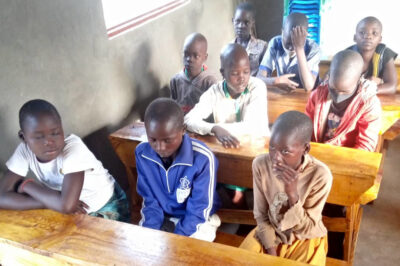When we envision a place of learning, one might see a big whiteboard, visual aids on the walls, cubbies, and bookshelves. Most importantly, one would envision desks. Desks are a fundamental piece of learning, and without them, students are left with nothing but their lap or a floor to work on. Now, when we think of a desk, we may visualize a smooth wood top with a hollowed-out space for scholastic materials. And if we visualize purchasing a desk, we may think of a bulk order from some big educational resource empire that handles the outfitting of thousands of classrooms around the world. Well, in Uganda, the value of a desk is far beyond a quick purchase from a magazine. Rather, it requires a much longer process that conceives hand-built furniture for students to use. Now, let’s get into the details of this process.

Step 1: Purchasing the Lumber
Okello began by traveling about 85km (~50mi) to the town of Lira, where the shops and markets are much bigger than in the town of Pajule. Here he purchased the necessary materials at a Lee Line Timber and paid a vehicle to transport them back to Pajule.
Step 2: Cut the Timbers
Fortunately, Okello David has a brother named Okello David John, who works with Okello Patrick (The Three Okellos!) and Lacek Ocot, as very skilled carpenters. These three craftsmen began by cutting the wood into the approximate sizes needed for the desks, aka “desk size”.

Step 3: Sand and Re-measure
Next, they sanded and polished each piece of wood and triple measured the sizes.
Step 4: Framing
This is where the components becomes the creation. Each piece of wood is put together and framed to be a desk.
Step 5: Lacquer the Final Product
The final touches of lacquer are brushed on to each of the masterpieces…and WAH-LAH! 35 brand new, handcrafted desks.


Each desk costs about 42,000 UGX ($11) in labor and can seat four nursery-level pupils or three primary-level pupils. In addition to the desks, the carpenters used the leftover pieces of timber, plus some older timber that was left from the construction of our P4 building, to make bookshelves for our K1, K2, and K3 classrooms!
When we envision our classrooms, we see very similar learning environments. Where one might see a whiteboard, we see a chalkboard. Where one might see computer-printed visual aids, we see handmade ones. And when one might see perfectly manufactured desks, we see imperfect sturdy places for learning. Nothing comes easily, and for that, every minute detail that blossoms from our efforts is deeply appreciated.

